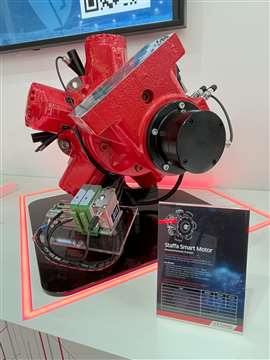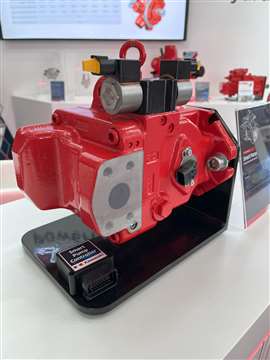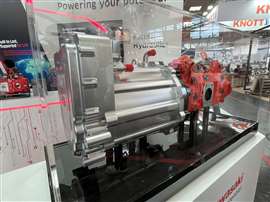Kawasaki debuts “Smart” hydraulics
09 May 2025
Kawasaki Precision Machinery (UK) Ltd. suppliers a full line of radial and axial piston motors, axial piston pumps as well as hydraulic valves and controllers. It is building on that lineup with “Smart” versions of both a motor and pump, as well as an all-new electric motor and pump combination, which it presented at Bauma 2025 last month.
 The Staffa Smart Motor features continuously variable displacement control. (Photo: Becky Schultz)
The Staffa Smart Motor features continuously variable displacement control. (Photo: Becky Schultz)
Kawasaki’s flagship product is the Staffa radial piston motor, which is manufactured in its facility in Plymouth, UK. At Bauma, it showed the Staffa Smart Motor, a new product that it said combines the durability of a hydraulic motor with the precision control of an electric drive.
The Staffa Smart Motor features continuously variable displacement control from full displacement down to 10% of maximum displacement (maximum and minimum displacement settings can be selected). The control system integrated into the motor is operated independently of the motor’s operating conditions to ensure smooth and stable operation over the full pressure-speed envelope.
“We’re actually measuring directly the displacement of the motor,” said Gareth Totman, senior application engineer, Kawasaki Precision Machinery (UK) Ltd.. “We’re also measuring speed and position.” Pressure sensors are used to measure pressure, as well.
“It’s all [communicated] over a CAN network, so you can interrogate the controller to get the signals out – you ask it what is the displacement, what is the speed? You can also give it instructions… to go to a specific displacement or a specific speed,” Totman said.
Electronic communication to and from the motor enables easy access to data on motor speed, torque, shaft power and displacement – all in real time. “So, if you had a situation where you had, let’s say, a test rig where you were using an expensive torque meter, you could have this… and you could get torque straight from the motor,” said Totman, negating the need for a costly component.
The data can also be used to control the motor – for example, to set the motor to hold a specific torque value. Displacement control and other changes can be made while the motor is under load and operating in either motoring or pumping mode.
Smart Pump
Kawasaki also showed its Smart Pump, which is based on the existing K3VLS axial piston pump. With an advanced electronic controller, it delivers precision, efficiency and seamless integration for mobile construction equipment, the company said.
 Kawasaki Smart Pump with advanced electronic controller. (Photo: Becky Schultz)
Kawasaki Smart Pump with advanced electronic controller. (Photo: Becky Schultz)
“We’ve added a non-contact swash angle sensor. There’s also a pressure sensor port – the end user can choose what pressure sensor they like. And then we have a new design proprietary regulator and pump controller,” said Totman.
“Very similar to the Smart Motor, you can now use this controller to emulate any other regulation type: pressure cutoff, torque limit, power shift, displacement control. You can select that in the UI with the Smart Motor controller and then you can [set parameters for] how you want the pump to work,” he explained. “If you select torque limit, for example, you can then say ‘I want torque limit control and I want 200 Nm’ and it will do the rest.”
The Smart Pump connects easily with machine control systems, which Kawasaki said cuts development time. It offers multi-mode control, customizable settings and a “smart design” with a virtual minimum displacement stop and poppet-type solenoid regulator to improve volumetric efficiency.
Initially, the Smart Pump control type will be introduced for the K3VLS85 axial piston pump, then will be expanded to the complete K3VLS and K3VL pump ranges.
K-Axle
Totman described the K-Axle as “future tech.” “This is new for us but it’s also future tech for the industry. This is a combination pump and motor,” he stated.
 Kawasaki K-Axle high-speed electric motor and pump unit. (Photo: Becky Schultz)
Kawasaki K-Axle high-speed electric motor and pump unit. (Photo: Becky Schultz)
This all-new high-speed electric motor and pump unit for construction machinery is designed to deliver high performance (105 kW rated power; 150 kW max power) in a scalable 50cc single or tandem unit at speeds of up to 5,000 rpm.
“The core of the motor is essentially an automotive electric motor but we’ve worked with a partner for the integrated inverter and the cooling jacket,” Totman said. “The pump itself is brand new. It’s a 50cc variable displacement pump.”
The K-Axle will be initially designed to replace the existing power pack in a diesel-powered excavator in the roughly 20-ton range. “It’s really compact, but it’s also operating at really high speeds – it’s operating up to 5,000 rpm, which is really high considering a typical diesel engine operates at 1,800 today,” Totman said.
Advanced control technology optimizes the operating speed and the swash angle of the pump to ensure the entire unit is operating in the most efficient range, he added.
The K-Axle is is designed to mount horizontally or vertically for flexible installation, and will be available in a single pump with a slightly smaller motor or in a dual pump configuration. According to Totman, “The idea being that if you have a larger flow requirement for the system, you just multiply the units rather than increase the size.”
POWER SOURCING GUIDE
The trusted reference and buyer’s guide for 83 years
The original “desktop search engine,” guiding nearly 10,000 users in more than 90 countries it is the primary reference for specifications and details on all the components that go into engine systems.
Visit Now
STAY CONNECTED




Receive the information you need when you need it through our world-leading magazines, newsletters and daily briefings.
CONNECT WITH THE TEAM









